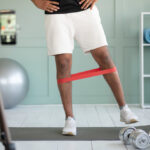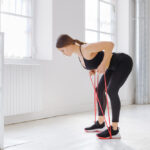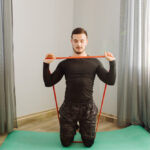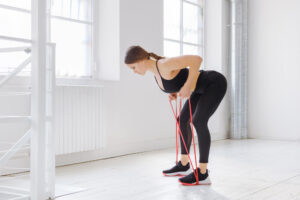Kettlebells aren’t just another trend in the fitness world; they are a versatile and powerful tool that can transform your workout routine, especially when it comes to enhancing shoulder strength and mobility.
These compact weights offer a unique mix of gravitational pull which differs from traditional dumbbells. This makes them perfect for a range of dynamic exercises that engage the whole body—shoulders included.
The importance of shoulder mobility
Mobility in the shoulders is crucial not only for athletes but for anyone who engages in physical activities. Good shoulder mobility enhances range of motion, decreases the risk of injury, and ensures that all movements are smooth and efficient.
For those who spend many hours at a desk, mobility work helps counteract the poor posture and stiffness associated with prolonged sitting. Kettlebell workouts, with their fluid motions, are excellent for challenging the shoulders to move through a full range of motion, thus improving overall joint mobility.
The role of strength in shoulder fitness
While mobility gets your shoulders ready for action, strength gives them the power and endurance to perform. Strengthening the shoulder muscles is essential for lifting, throwing, and carrying activities.
Kettlebell exercises build strength not just in the muscles but also in the connective tissues of the shoulders, making them more resilient and less prone to injury. The unique swinging motions of kettlebell workouts engage multiple muscle groups simultaneously, offering a comprehensive strength workout that benefits the shoulders extensively.
Essential kettlebell exercises for shoulders
Kettlebell press
The kettlebell press is fundamental for building shoulder strength and stability. To perform this exercise:
- Stand with your feet shoulder-width apart.
- Hold a kettlebell in one hand and clean it to your shoulder, fist close to your chin.
- Press the kettlebell upwards until your arm is fully extended overhead.
- Lower it back down to the shoulder in a controlled motion.
- Repeat for several reps before switching arms.
This exercise not only works the deltoids but also engages the core and improves overall upper-body strength.
Kettlebell halo
The kettlebell halo is excellent for enhancing shoulder mobility and warming up the upper body:
- Hold the kettlebell by the horns with both hands.
- Bring it around your head in a circular motion, close to your scalp, moving it around your head like a halo.
- Keep your core tight and your posture upright throughout the movement.
- Perform the motion in both clockwise and counterclockwise directions to maintain balance in muscle development.
This exercise is gentle yet effective at opening up the shoulder joints and preparing them for more intense workouts.
Kettlebell windmill
The windmill combines flexibility, mobility, and strength in one fluid motion:
- Start with your feet slightly wider than shoulder-width apart.
- Hold a kettlebell in your right hand and press it overhead.
- Turn your feet at a 45-degree angle away from the arm holding the kettlebell.
- While keeping your arm extended, bend at the waist and lower your left hand towards your left foot.
- Look up at the kettlebell as you descend.
- Reverse the motion to return to the starting position.
- Complete several reps before switching sides.
This exercise targets the shoulder stability and stretches the hamstrings, making it a dual-purpose movement.
If you need more ideas for your kettlebell workouts, get in touch with our personal trainers in Fayetteville.
Safety tips and best practices
When it comes to kettlebell workouts, particularly for the shoulders, the risk of injury can be minimized with proper technique and awareness. Here are a few key points to keep in mind:
- Start with a suitable weight: Always begin with a kettlebell weight that you can manage comfortably. This helps in mastering the form without straining your muscles.
- Warm-up properly: Engaging in a thorough warm-up session increases blood flow to the muscles and prepares your joints for the workout, significantly reducing the risk of injury.
- Focus on form, not speed: Kettlebell exercises are often performed in a dynamic manner, but it’s crucial to prioritize correct form over the speed of execution to avoid unnecessary stress on the shoulder joints.
- Use a good grip: A firm and secure grip on the kettlebell ensures that it doesn’t slip during the workout, especially when you’re sweating. Chalk can be used to improve grip stability.
When to increase weight or intensity
Progressing in your kettlebell workout should be done thoughtfully to avoid overloading the shoulders. Increase the weight or intensity of your workouts only when you can perform the current exercises with perfect form and relative ease. This gradual progression not only builds strength effectively but also safeguards against the potential for injuries.
Also, for your next leg day, we’ve prepared tips on how to prevent injury by learning these top kettlebell squat mistakes and how to avoid them.
Final thoughts
Kettlebell shoulder workouts are an exceptional way to build strength and enhance mobility, offering a robust and varied approach to shoulder health. By incorporating exercises like the kettlebell press, halo, and windmill, you can develop a shoulder routine that not only builds muscle but also improves joint function and overall physical resilience. Remember to start slow, focus on your technique, and gradually increase the intensity of your workouts as you grow more comfortable and stronger. With consistency and proper practice, kettlebell workouts can be a key component of a balanced fitness regimen, leading to better performance and fewer injuries.







